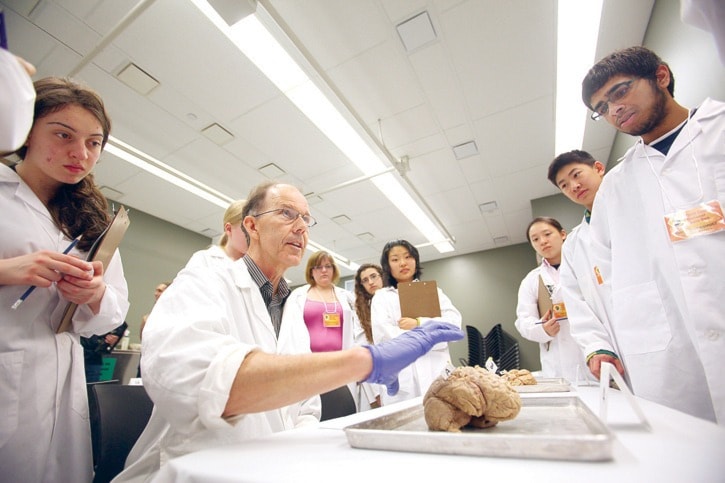Kay Hung saw a human brain for the first time last weekend.
She saw 20 of them, in fact, while participating in the Canadian Institute of Health Research’s national Brain Bee at McMaster University.
The Grade 12 Semiahmoo Secondary student had to identify areas of the specimens that were marked with a pin – the same exam given to McMaster medical students – as part of the day-long competition against 12 other youth from across the country.
“It was pretty interesting,” Hung said, noting the test was a difficult one to prepare for. “It’s hard to study for something you don’t really see in 3D.”
Hung, 17, was chosen to represent the province at the contest after winning Vancouver’s third annual Brain Bee at University of British Columbia in April. It was her second shot at the local event after placing seventh last year.
Students were given a book to study from before answering questions on the brain and neuroscience research in a written exam. The top scoring students then moved onto an oral round of questions judged by a panel of UBC professors.
After placing first in a subsequent elimination round, Hung was awarded a trip to Ontario for nationals, held last Saturday (May 28).
“It was exciting because it meant another book to study, more information to learn.”
Hung – who studied for the competition while also preparing for her final exams in Semi’s International Baccalaureate program – first had her skills put to the test with a morning multiple-choice written exam.
In the following neuro-anatomy test, Hung said she recognized one brain to be from an adolescent, and noticed a few others with signs of pathology. The latter were “shriveled up” and had deeper grooves, which she identified as a result of Alzheimer’s.
Afterward, Hung and her fellow competitors – who ranged from Grade 9 to 12 – underwent a patient diagnosis exam in the Centre for Simulated Learning, where medical students train.
The station was set up with realistic medical offices, real equipment and actors pretending to be patients with brain disorders or diseases.
Hung said she was given five minutes to ask each patient yes or no questions, and had to determine diagnoses based on their answers. Out of the eight scenarios, she only made one mistake. There was finally an oral question round before the scores were tallied and the top students moved forward.
Soohyun Park from Toronto took first place overall and will be representing Canada at the International Brain Bee in Florence, Italy in July, which will be held in conjunction with the eighth IBRO (International Brain Research Organization) World Congress of Neuroscience.
Dave Saraswat of Edmonton placed second, and George Charchoghlyan of Guelph came in third.
The purpose of the competition, according to organizers, is to stimulate interest and excitement about brain research, as well as encourage young minds to pursue an education in the subject.
While Hung said she learned a lot about neuroscience during the event, it wasn’t her first time delving into the field.
After job-shadowing at the neuro-immunology labs at UBC during her Grade 10 year, Hung was invited back that summer to volunteer as a lab assistant, where she helped organize patient data relating to neurological disease myasthenia gravis.
“My placement there encouraged me to look more into the nervous system in general and how it relates to the immune system,” she said. “That’s where the interest in that department came from.”
But Hung said she still finds all fields of science interesting, and plans on studying general science and engineering when attending Stanford University in California next year.
She said she likes “finding out the way things work,” and enjoys the creative aspect of problem solving.
It’s also an exciting time for science, she noted.
“We’re on the brink of some major discoveries. It’s possible that our generation will be the one to figure everything out because there’s already been so much research done.”
